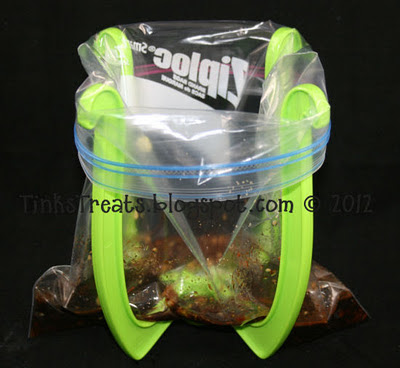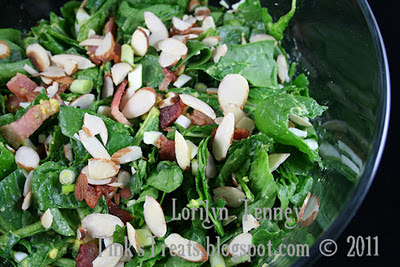
In November, the Daily News ran an article about food trends for 2012. The New York based international food consultant company, Baum + Whitman predicted that Korean flavors could be the It flavor offered by chain restaurants in 2012. Their observation of global eating habits over the last few years shows that when the economy took a down-turn, the American people turned to what they call "crisis foods". Inexpensive comfort foods like meatloaf, macaroni and cheese and roast chicken made a big comeback, but these days our palettes are getting bored with those flavors, and we're looking to put some life back onto our plates. Then, last week I was looking for ways to use up round steak when I found this
Korean Sirloin recipe posted on Food.com by Jolene#20fan. Remembering the article I had read, I decided to try it.
I love the idea and the results of marinades, but the process of getting the meat into a giant, floppy bag full of liquid can get a little tedious. It's one of the first things that popped in my mind when I saw a new gadget on the market called the Bagwell. Essentially, a sturdy plastic base that holds your Ziplock bag up and open while you fill it. The other time I find myself needing something like this is when I buy meats in bulk, portion them out into bags, and then use the FoodSaver vacuum sealer to prepare them for freezing. After doing this for over 10 years, I've developed a system for the procedure, and a sizable collection of glass liquid measuring cups to hold the bags as I fill them. The only trouble is that a bag stuffed inside a glass measure leaves only a small amount of room to fill before overflowing. When I tested the Bagwell last week, using several pounds of ground beef, I was very impressed with the large mouth in which to fill the bag, and that the bag was suspended at least 6 inches above the counter. That meant I could fill the bag easily with a full pound of ground beef, while not juggling several small amounts of raw meat and an unruly baggie.
As you all know, I'm an admitted Gadget Junkie and can't resist testing out any kitchen gadget that I see or hear about. The Bagwell was one of those gadgets that makes you think, "Now why didn't I think of that?!" It's such a simple idea, but for $10 it's one of the most useful gadgets in the house. It folds flat, about an inch tall, is dishwasher safe and was quite sturdy considering what I was using it for. The FoodSaver bags were not what the Bagwell was designed for, so they were a little stiff and took some coaxing to get the bags over the four Bagwell arms, but once they were on they were held open a good four inches square, making filling them really easy.

The Bagwell with a FoodSaver bag. Note the large mouth for filling:

Since I had decided to make the Korean marinade within a day or two of getting the Bagwell, I was able to test it's usefulness with the resealable-type bag that it's designed for. I have a large, flat container made just for marinating meats, but I never use it. I prefer to use Ziplock bags for marinating instead. They take up less room in the refrigerator and it's easier to shake and re-distribute the meat and marinade periodically. It could not have been easier to fill a Ziplock with marinade ingredients and large chunks of round steak than it was with the Bagwell. The gallon-size Ziplock went smoothly over the four Bagwell arms and I found that being able to measure ingredients, and even grate fresh ginger, directly into the bag was not only a time-saver, but it saved me from washing extra dishes. I haven't tried it yet, but I can tell that this gadgie will also be like having an extra hand when trying to pour leftovers into a bag from a large pot. I make a lot of recipes that will divide into several meals, that I bag, label and freeze for busy nights. The Bagwell will make doing the OAMC (Once A Month Cooking) technique even more efficient.
The Bagwell with Ziplock bag for marinating:

The Korean marinade goes together easily, with mostly pantry items and can marinate in as little as one hour. It's great for those of us that usually decide to make this kind of recipe with only an hour to spare before mealtime. Since I already had lasagna in the oven, but was playing with my new Bagwell, I made the marinade then and the meat ended up marinating for 24 hours. The only complaint about this dish was from Bryan, who doesn't like the strong flavor that fresh ginger imparts. I'll just reduce the amount of ginger next time. The following night I used the George Foreman indoor grill to cook the marinated meat, the microwave to bake some potatoes, and we had a delicious meal on the table in less than 20 minutes. This is definitely a main dish that can be assembled, bagged, and frozen for future use. Just transfer the bag from freezer to refrigerator the night before, or the morning of, and let the meat marinate as it thaws. This is my version of the original recipe, as I don’t like to cook and eat the liquid that the raw meat has marinated in, so I doubled the marinade ingredients and reserved half for the sauce. I suggest serving this recipe on a bed of white rice with a side of steamed broccoli. Delicious!
Korean Sirloin1 cup reduced sodium soy sauce
4 tablespoons grated peeled fresh ginger
2 tablespoons brown sugar
2 tablespoons sesame oil
1/2 teaspoon cayenne pepper
6 garlic cloves, finely chopped
1 boneless top sirloin steak, 1 inch thick or 1 top round steak, 1 inch thick
In a large re-sealable bag, combine soy sauce, ginger, brown sugar, sesame oil, cayenne and garlic. Remove about 1/2 cup of the marinade to a small bowl (or baggie), cover and refrigerate for later. Add the steak to the large baggie, seal and turn to coat. Refrigerate for 1 to 4 hours, turning bag several times. Heat a ridged grill pan over medium-high heat until very hot. Remove the steak from the bag, pat dry with paper towels and cook for 6 to 8 minutes per side for a medium rare steak. Remove steak to a cutting board and let stand for 10 minutes. Pour the reserved marinade into a small saucepan and add 2 tbsp of water. Heat to boiling, and boil for 2 minutes. Slice the steak into thin strips, diagonally against the grain and serve with the cooked sauce.










